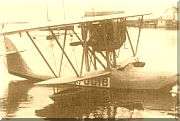CANT 18
The CANT 18 was a flying boat trainer developed in Italy in the 1920s to prepare pilots for flying boat airliners. A development of the CANT 7, it incorporated various aerodynamic and hydrodynamic refinements. While remaining broadly similar in configuration, the new design replaced the CANT 7's conventional struts with Warren truss bracing for the wings. Most of the aircraft produced were used by S.I.S.A..
| CANT 18 | |
|---|---|
 | |
| Role | Flying boat trainer |
| Manufacturer | CANT |
| Designer | Raffaele Conflenti |
| First flight | 1926 |
| Primary user | SISA |
| Number built | 29 |
Specifications
General characteristics
- Crew: 2, pilot and instructor
- Length: 8.68 m (28 ft 6 in)
- Wingspan: 10.50 m (34 ft 5 in)
- Empty weight: 975 kg (2,150 lb)
- Powerplant: 1 × Isotta Fraschini V.6 Six-cylinder, water-cooled, in-line piston engine , 187 kW (250 hp)
Performance
- Maximum speed: 190 km/h (120 mph, 100 kn)
- Range: 600 km (374 mi, 325 nmi)
- Service ceiling: 5,500 m (18,040 ft)
gollark: Well, you could just give it access to Flask, probably.
gollark: No. What would that even involve?
gollark: It's very annoying. Even though we use osmarkslisp™-2038 and HeavLisp8 on many of our things, we still use BCPL as a backend for some things.
gollark: `'()`
gollark: This is because the interpreter is only capable of tail call optimization and not arbitrary stack depth in general.
See also
Related lists
- List of seaplanes and flying boats
References
| Wikimedia Commons has media related to CANT 18. |
- Taylor, Michael J. H. (1989). Jane's Encyclopedia of Aviation. London: Studio Editions. p. 269.
- aerei-italiani.net
This article is issued from Wikipedia. The text is licensed under Creative Commons - Attribution - Sharealike. Additional terms may apply for the media files.